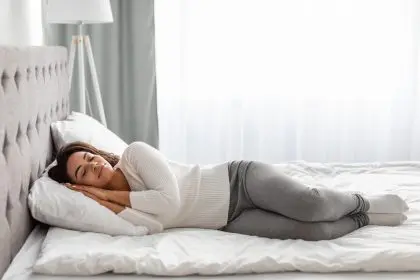In the heat of summer, many of us find solace in the cooling breeze of a fan as we sleep. However, while it might provide immediate comfort, sleeping under a fan can lead to various health issues. This article will explore why this seemingly harmless habit can be problematic for your health, the specific risks involved, and practical tips to mitigate these effects. By understanding these concerns, you can make informed choices for a healthier and more restful night’s sleep.
The immediate comfort vs. long-term risks
Sleeping under a fan is common, especially in areas where air conditioning is not prevalent. The immediate relief from heat is undeniable, making it easier to fall asleep. However, this comfort can come at a cost to your health. Here are some of the primary health issues associated with sleeping under a fan:
- Dryness and irritation: The constant flow of air from a fan can dry the skin, eyes, and respiratory system, causing irritation, itching, and discomfort. People with sensitive skin or conditions like eczema may experience exacerbated symptoms, making it harder to get a restful night’s sleep.
- Allergic reactions: Fans can circulate dust, pollen, and other allergens around the room. This can trigger allergic reactions, especially in individuals prone to allergies or asthma. Symptoms like sneezing, coughing, and a runny nose can disrupt sleep and overall health.
- Muscle stiffness and cramps: Prolonged exposure to cool air can cause muscle stiffness and cramps. This is particularly noticeable in the neck and shoulders, leading to discomfort and pain that can last throughout the day. Waking up with a stiff neck or sore muscles can significantly impact your daily activities and overall well-being.
The impact on respiratory health
One of the most concerning aspects of sleeping under a fan is its impact on respiratory health. Here’s how it affects the respiratory system:
- Dry throat and nasal passages: The continuous flow of air can dry out the mucous membranes in your throat and nasal passages. This dryness can lead to a sore throat, difficulty swallowing, and an increased risk of infections. For individuals who snore, the dryness can worsen the condition, leading to more severe disruptions in sleep.
- Increased risk of sinus issues: Sleeping under a fan can cause sinus congestion and headaches. The cool air can inflame the sinuses, leading to discomfort and pressure. This is particularly problematic for individuals who already suffer from sinusitis or other sinus-related issues.
- Aggravation of asthma symptoms: For asthma sufferers, the circulation of dust and allergens by a fan can trigger asthma attacks. This can lead to shortness of breath, wheezing, and chest tightness, severely impacting sleep quality and overall health.
Practical tips to mitigate health risks
While the health issues associated with sleeping under a fan are concerning, there are practical steps you can take to mitigate these risks and still enjoy a comfortable night’s sleep:
- Use a humidifier: Placing a humidifier in your bedroom can help counteract the drying effects of the fan. This will keep the air moist, reducing the risk of dryness and irritation of the skin, eyes, and respiratory system.
- Regularly clean your fan: To minimize the circulation of dust and allergens, regularly clean your fan blades and grills. This simple maintenance step can significantly reduce the amount of dust and allergens in the air, helping to prevent allergic reactions and respiratory issues.
- Adjust fan placement and speed: Position the fan to circulate air indirectly rather than blowing directly on you. Additionally, using the fan at a lower speed can provide sufficient cooling without the adverse effects of direct, strong airflow.
- Stay hydrated: Drinking plenty of water before bed can help keep your mucous membranes hydrated. This can reduce the risk of dryness and irritation caused by the fan’s airflow.
- Consider alternatives: Explore alternatives like air conditioning, which can provide controlled cooling without the direct airflow of a fan. While more expensive, it offers a healthier option for cooling your sleeping environment.
Conclusion
While the comfort of sleeping under a fan is undeniable, it’s essential to be aware of the potential health issues that can arise from this practice. Dryness, allergic reactions, muscle stiffness, and respiratory problems are some of the key concerns. By taking practical steps such as using a humidifier, cleaning your fan regularly, adjusting its placement, and staying hydrated, you can mitigate these risks and enjoy a healthier night’s sleep. Ultimately, understanding the balance between comfort and health will help you make better choices for your sleep environment. Embrace these changes for improved well-being and a more restful, rejuvenating sleep experience.












